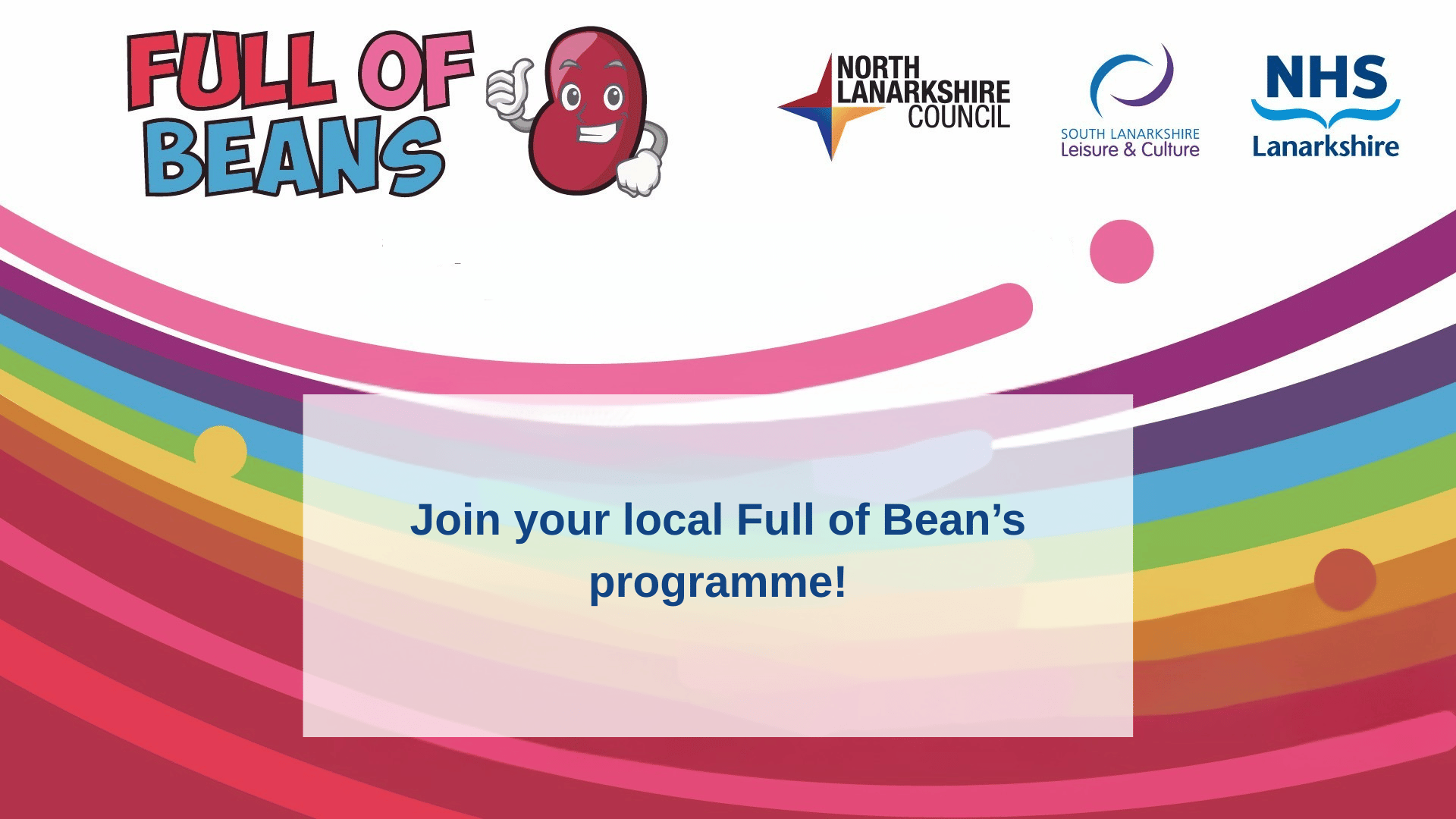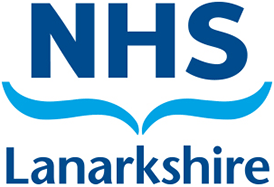Full of Beans

Take part in all the fun that Full of Beans has to offer!
Full of Beans is a fun, free healthy lifestyle class for children aged 18 months – 5yrs and their families. Our programme, which runs over 10 weeks, is inviting all families from across Lanarkshire to come along.
Run in partnership with North Lanarkshire Council – Active & Creative Communities and South Lanarkshire Leisure and Culture, each session involves everyone learning about healthy lifestyle changes and getting involved in the Full of Beans song, before playing exciting games.
Classes last 1 hour and each week has a new theme for families to learn about.
What you can expect:
- Kids will take part in plenty fun games to help burn off energy, including: The Bean Game, Traffic Lights, parachute and balloon activities and more!
- NHS staff will share handy hints and tips on fussy eating, healthy snacking, low budget toddler friendly recipes, managing screen time and portion sizes
- Come with any questions you have re supporting a healthier lifestyle for your family
Here is what our participants had to say:
“My daughter loved the games and Full of Beans song. The staff are very friendly and have plenty time for the children. We’ve learned many games which we do at home to keep us all active.”
“My wee boy loved kicking the ball with Paul. He has learned his colours and how to identify his fruit and veggies. We also learned many tips on healthy eating.”
Brothers/sisters/family members are also welcome along too.
Sign up or find out more:
South
Rutherglen
Springhall Community Centre
30 Cruachan Rd, G73 5EL
Tuesdays from 12 January, 1pm-2pm
Carluke
Carluke Leisure Centre
135 Carnwath Rd,ML8 4EA
Wednesdays from 12 January, 10am-11am
East Kilbride
East Kilbride Central Library
The Olympia Shopping Centre, Churchill Ave, G74 1PG
Thursdays from 12 January, 10.45am-11.45am
Hamilton
Fairhill Lifestyles
Neilsland Rd, ML3 8HJ
Fridays from 12 January, 10am-11am
North
Cumbernauld
Broadwood Community Centre, 1 Ardgoil Dr, G68 9NE
Mondays from 12 January, 11pm-12pm
Coatbridge
Time Capsule, 100 Buchanan Street, ML5 1DL
Tuesdays from 12 January, 10am-11am
Those attending the North Lanarkshire Full of Beans sessions will also be able to access the soft play areas within the venue for free after the class ends. You can only attend the soft play free if you attended the session that day, this can not be used any other day.
Or email Louise Borthwick, BorthwickL@northlan.gov.uk
Take part in Full of Beans from home
Nutrition for children and young people
The age and stage of your child will mean they need different nutrients from food to grow and stay healthy.
Children aged 1 – 4 years old
Children aged 1 to 4 years are growing really quickly so they need a healthy mix of food in smaller amounts. This is to make sure they get everything they need in toddler sized portions. Things you can do to help make your child’s food as healthy as possible are:
- Keep to a routine with meals and snacks when you can
- Aim for 3 small main meals per day with a good mix of healthy food, and offer 2-3 snacks per day like fresh fruit or yoghurt. Think 5 5 3 2: 5 portions of starchy foods, 5 portions of vegetables and fruits, 3 portions of dairy foods, 2 portions of protein (meat, fish or poultry) or 3 portions of vegetarian protein (such as soy, quorn)
- Try slowly adding high fibre starchy foods to their diet, these can fill up little tummies very quickly meaning your child might ignore other important bits of their meal
Some food tastes and textures take a little practice to eat, but we know that young children who are able to learn about healthy food by eating it early on will find it easier to eat that way for life. See the section below on Food Preferences and Fussy eating for more advice.
We know that getting all the bits of a healthy diet into young children can be hard so we recommend extra vitamins A, C & D are given to children aged 6 months to 5 years old. Ask your Health Visitor or doctor about healthy start vitamins
We know that foods and drinks that are high in sugar are best kept as special treats and eaten only sometimes, and are also better as part of a meal. By having less special treats we help children learn to enjoy foods that are low in sugar as well as making sure they don’t get too much food energy from sugar or risk problems with their teeth.
We recommend working towards making meals match the healthy mix of food in The Eatwell Guide by the time your child is 5.
More hints and tips for children aged 1 – 4 years old:
General advice for parents/carers
- Add little or no salt during cooking and don’t add any salt to food after cooking,
- Nuts should not be given to children under 5 years of age (nut butters or ground nuts are ok if there have no nut allergies).
- Oily fish/shellfish and liver should be given no more than twice a week.
- Offer other types of snacks to replace foods high in saturated fat, salt and sugar; for example crisps sweets, chocolate, pastries and cakes should be given as special treats only
- Special Treats include foods which contain added sugars or hidden sugars, for example fruit sugars (fructose) or syrups.
- Fruit juice and squash (diluting juice) are best given only at mealtimes so offer water or milk first at mealtimes and in between.
Food preferences and 'fussy eating'
It is common for children to stop eating foods they have previously taken and vice versa. This is sometimes called displaying food preferences and is a completely normal stage in the way children react to food, it can last for a long time and it will be different for every child.
We can encourage our children to accept the food over time by using a consistent, calm approach. By gently and positively offering foods that have been rejected children are more likely to eventually accept the food, and be more willing to try other tastes later on. It can take between 5-15 tries before some foods are accepted, keep offering!
For practical tips around food preferences have a look at Parent Club, NHS and Nutrition Scotland.
Children aged 5+
From 5 years onwards children and adults should follow the recommendations outlined in the Eatwell Guide:
- Eat at least 5 portions of a mixture of fruit and vegetables every day
- Use higher fibre starchy foods in meals, like potatoes in their skins, wholegrain breads, rice or pastas
- Have some dairy or dairy alternatives (soya/oat/nut milks/yoghurts)
- Eat some beans, pulses, fish, eggs, meat and other protein
- Choose unsaturated oils and spreads instead of saturated fats, and eat these in small amounts
- Drink plenty of fluids, at least 6 to 8 glasses a day- water is best
You do not need to achieve this balance at every meal; it is a guide to the mixture of foods you should be eating over a day or a week.
More hints and tips for children aged 5+:
Portion sizes
Portion sizes will be different for children and young people. Generally the bigger they are, the bigger their portions need to be. If you have more active children they will need to eat more. Because teenagers are growing quickly, they have higher food energy needs so portion sizes can be the same as an adult’s. Using our hands can give us a good idea of portion sizes for each of the family, as our hand sizes match our energy needs! Have a look at the British Nutrition Foundation’s Handy Portion Guide for more information.
Food labels
Food labels can help you to choose foods which have healthier amounts of energy, fat, saturated fat, sugar and salt. Some food packaging has traffic light labels with high (red), medium (orange) or low (green), this is an easy way to see how much fat, saturated fat, sugars and salt are inside.
- Red traffic lights mean the food or drink contains a high amount of the type of ingredient so we should try to have these foods less often or eat them in small amounts.
- Orange traffic lights means the food contains a medium amount of this type of ingredient so if a food contains mostly orange you can eat it most of the time.
- Green traffic lights means the food contains a low amount of this type of ingredient, so the more green lights a label has the healthier the choice.
We can use the traffic light labels to choose more foods with greens and oranges, and use less reds. We can see more easily if other similar products have lower amounts of sugar, fats and salts.
Find out more about food labels.
Cooking
We can make our meals healthier by cooking meals from scratch, as we can control the amounts and types of salt, sugars and fats added. Children love getting involved in cooking, plus it helps them to develop practical food skills, learn about food and health and even encourages them to try new things. If you are less confident in the kitchen you can learn together with family cooking ideas that encourage children to get involved. There are several resources available to support family cooking that can encourage children to get involved. Such as Parent Club and Food a Fact of Life.

